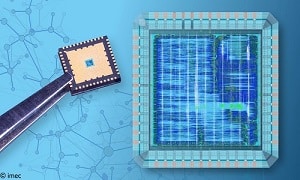- The chip’s operation resembles the processing of information by biological neurons
- Consumes much less power than traditional neural networking chips while featuring a tenfold reduction in latency for instantaneous decision-making
 Artificial neural networks (ANNs) are the backbone of artificial intelligence (AI) and machine learning (ML). Its implementation is essential for a wide range of AI applications. For instance, radar-based anti-collision systems commonly used in autonomous driving vehicles. However, ANNs consume too much power, making it a challenge to be integrated into increasingly constrained sensor devices. Also, ANNs’ underlying architecture and data formatting make data-travel a time-consuming procedure from the sensor device to the AI inference algorithm for a decision to be made.
Artificial neural networks (ANNs) are the backbone of artificial intelligence (AI) and machine learning (ML). Its implementation is essential for a wide range of AI applications. For instance, radar-based anti-collision systems commonly used in autonomous driving vehicles. However, ANNs consume too much power, making it a challenge to be integrated into increasingly constrained sensor devices. Also, ANNs’ underlying architecture and data formatting make data-travel a time-consuming procedure from the sensor device to the AI inference algorithm for a decision to be made.
To overcome this challenge, Imec, an organisation involved in the research and development of nanoelectronics and digital technologies has developed a chip that makes use of spiking neural networks (SNNs).
What are spiking neural networks?
Both artificial neural networks (ANNs) and spiking neural networks (SNNs) are inspired by biological neural networks. While ANNs function by transmitting signals continuosly based on inputs accumulated from each neuron, SNNs fire (or transmit) signals when the threshold limit for a value is reached in the form of a spike. The entire difference is similar to the propagation of a continuous-time signal and discrete-time signal.
“SNNs operate very similarly to biological neural networks, in which neurons fire electrical pulses sparsely over time, and only when the sensory input changes. As such, energy consumption can significantly be reduced. What’s more, the spiking neurons on our chip can be connected recurrently – turning the SNN into a dynamic system that learns and remembers temporal patterns. The technology we are introducing is a major leap forward in the development of truly self-learning systems,” said Ilja Ocket, program manager of neuromorphic sensing at imec.
The chip was initially designed to support electrocardiogram (ECG) and speech processing in power-constrained devices. But thanks to its generic architecture that featured a completely new digital hardware design, it was decided to reconfigure this design for processing of sonar, radar and lidar data. Contrary to analogue SNN implementations, the event-driven digital design of the chip makes it behave exactly and repeatedly as predicted by the neural network simulation tools.
Autonomous applications
The chip is a smart solution for implementing low-power, anti-collision system for drones and autonomous cars. With both operating in varying environments, rapid response to the surrounding changes is required to perform efficiently.
“The creation of a low-latency, low-power anti-collision system using this chip enables the radar sensing system to distinguish much more quickly – and accurately – between approaching objects. In turn, this will allow an instantaneous reaction to potentially dangerous situations,” says Ilja Ocket. “One scenario we are currently exploring features autonomous drones that depend on their on-board camera and radar sensor systems for in-warehouse navigation, keeping a safe distance from walls and shelves while performing complex tasks. This technology could be used in plenty of other use-cases as well – from robotics scenarios to the deployment of automatic guided vehicles (AGVs) and even health monitoring.”
“This chip meets the industry’s demand for extremely low-power neural networks that truly learn from data and enable personalized AI. For its creation, we rallied experts from various disciplines – from the development of training algorithms and spiking neural network architectures that take neuroscience as a basis, to biomedical and radar signal processing and ultra-low power digital chip design,” said Kathleen Philips, program director of IoT cognitive sensing at imec.






